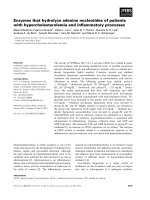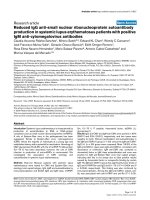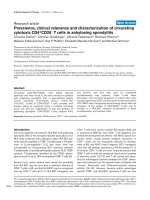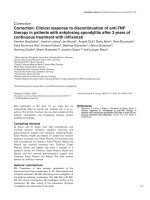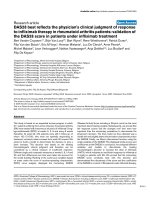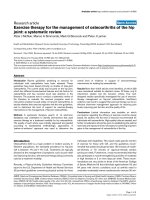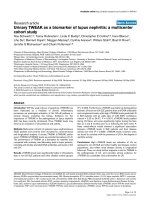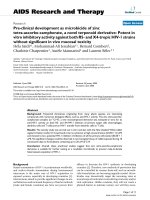Báo cáo y học: " Pro/con clinical debate: The use of prone positioning in the management of patients with acute respiratory distress syndrome" potx
Bạn đang xem bản rút gọn của tài liệu. Xem và tải ngay bản đầy đủ của tài liệu tại đây (41.87 KB, 4 trang )
ARDS = acute respiratory distress syndrome.
Available online />A 29-year-old obese man is involved in a motor vehicle
accident and has a pulmonary contusion that results in
severe acute respiratory distress syndrome (ARDS). He is
mechanically ventilated with volume cycle ventilation (tidal
volume, 6 ml/kg ideal body weight), a positive end-expiratory
pressure of 18 cmH
2
O, and a fractional inspired oxygen
concentration of 0.8. His injuries are minimal and do not
prevent him from being moved. Given your concerns about
his oxygenation, you wonder whether there might be a benefit
to prone positioning.
Commentary
Pro/con clinical debate: The use of prone positioning in the
management of patients with acute respiratory distress
syndrome
John J Marini* and Gordon Rubenfeld
†
*Professor of Medicine, University of Minnesota, USA
†
Assistant Professor, Harborview Medical Center, Washington, USA
Correspondence: Critical Care Forum Editorial Office,
Published online: 17 January 2002
Critical Care 2002, 6:15-17
© 2002 BioMed Central Ltd (Print ISSN 1364-8535; Online ISSN 1466-609X)
Abstract
Critical care medicine is a relatively new specialty and as such there is not a great deal of accumulated
data to allow clinicians to practice ‘evidence-based medicine’ in all situations they encounter. When
evidence does exist, intensivists may choose not to follow it based on ‘gut feelings’ or their own
interpretation of how the data apply to their patient. It is perhaps not surprising that these latter events
occur given that intensivists are often literally fighting for their patient’s lives. Prone positioning evokes
a large emotional response from many intensivists. Despite accumulating data there appears to be two
camps of clinicians: those who strongly believe in the therapy, and those who want more data. The
emotion and rationale for the mindset of the two camps is evident in this issue of Critical Care Forum.
With compelling arguments on both sides of the fence, it is apparent that this debate is far from over.
The authors of this pro/con debate, which is based on a clinical scenario, first describe their position
and then respond to their opponent’s position.
Keywords: prone position, ventilation, ventilation–perfusion ratio
The scenario
Pro: prone positioning is useful in the management of ARDS patients
John J Marini
Critically ill patients are frequently immobilized in the supine
position for days to weeks with periodic 15–30° lateral
positioning. Supine positioning allows access to vital
structures, facilitates catheter placement, allows the patient
to face caregivers and family, and avoids potential
pressure-related complications, such as ocular injury,
jugular vein compression, and skin ulceration at points of
increased pressure (for instance, the nose, chin, or knees).
Maintaining a supine position may also be mandated by the
underlying condition (such as anterior burns or massive
ventral trauma). In nature, however, an unrelieved supine
orientation is never encountered for extended periods;
postural variation is innate. Moreover, if one horizontal
orientation is to be preferred, there are five reasons for
choosing the prone position in preference to the supine
position.
Critical Care February 2002 Vol 6 No 1 Marini and Rubenfeld
Firstly, sinus and airway anatomy affords more efficient
secretion drainage when prone. Secondly, the lung fits into
the prone thorax with less distortion. This improved fit results
from the repositioned diaphragm and heart; the heart
compresses the dorsal lung when supine and rests on the
sternum when prone [1].
Thirdly, the supine position predisposes to airway closure in
the dorsal regions that receive the majority of blood flow [2].
Regional ventilation-to-perfusion relationships are more
uniform in the prone position, especially in patients with
ARDS. Increased ventilation-to-perfusion uniformity improves
gas exchange to a clinically meaningful extent in most
patients with ARDS when they are turned to the prone
position [3,4]. Obese patients and those with congestive
heart failure also benefit from prone positioning [5]. Because
the distribution of ventilation improves, reduced chest wall
compliance in the prone position may improve rather than
impair oxygenation [6].
Fourthly, improved and/or more sustained response to
recruiting maneuvers occurs in the prone position [7]. Finally,
animal models have shown that, for the same pattern of
ventilatory pressures, the prone position protects better
against ventilator-induced lung injury [8].
Clinical experience
Prone positioning has improved arterial oxygenation in all
studies in patients with ARDS that have examined the
question, especially in the early phase of illness [3].
Disappointingly, however, in the only randomized, controlled
study of proning yet published, 6 hours of prone positioning
did not influence mortality in the diverse patients entered
from a large number of Italian centers [9]. Apart from
questions that beset the majority of multicenter trials in
patients with ARDS, such as definitional precision, co-
intervention control, and execution variability across and
within centers, this result hardly constitutes a basis for
discarding the practice for many study-specific reasons.
Firstly, the brief duration of ‘proning’ (both in terms of number
of hours per day and number of days) may not have been
adequate. Secondly, the study was terminated prematurely
before even one-half of the targeted number of subjects for
whom the study was powered were enrolled. This was
because the enrollment rate dwindled as the study
proceeded, primarily because many investigators perceived
that withholding the option to prone was unethical, based on
their early experience.
Thirdly, a post hoc analysis of the data indicated a marked
mortality benefit with proning in the subset of patients most
seriously ill (see Fig. 1), and in those ventilated with the high
tidal volumes (≥12 ml/kg) associated with higher mortality in
the ARDS Network tidal volume trial [10]. Finally, as in all
previous reports, proning was hemodynamically well tolerated
and the incidence of serious iatrogenic complications, such
as unintended extubation or skin ulceration, were no more
common in the group whose position was varied than in the
group that remained continuously supine.
Figure 1
Proning may benefit the most seriously ill subset of patients with acute
respiratory distress syndrome. Those in the quartile with the highest
Simplified Acute Physiology Score II (SAPS II) have a marked mortality
benefit with ‘proning’.
Quartiles of SAPS II
Mortality rate
>49 40–49 31–40 0–31
Supine
Prone
* < 0.05 versus supine
P
*
Con: prone positioning is not useful in the management of ARDS patients
Gordon Rubenfeld
Imagine the following scenario. A novel treatment for a critical
illness syndrome is reported in a case series [11,12]. Animal
models support a physiologic rationale for the treatment, and
small clinical trials look promising [8,13]. Finally, a large,
randomized clinical trial is performed but the treatment has
no effect on mortality [9]. Advocates regroup and claim that
the wrong patients and doses were used, that there were
baseline imbalances, and that the sample size was too small.
Critics exult that it is time to stop using this treatment. This
familiar story has recently been retold about prone ventilation
for the management of ARDS patients [9].
A review of the clinical trial shows that, like inhaled nitric oxide,
prone ventilation improves oxygenation without affecting
mortality. Prone ventilation was neither free of cost nor
completely safe; it required an additional 90 person-minutes of
time per day to position the patient and was associated with an
increase in pressure ulcers, sedation needs, muscle relaxants,
and ventilator discoordination. Of course, advocates of prone
ventilation found solace in the arguments people resort to after
negative clinical trials: ‘proning’ may still reduce mortality, but
only in patients with the most severe ARDS; and negative trials
do not prove that a treatment is useless.
Rather than enter the usual fray, let me suggest another
route to understanding this debate [14]. At the heart of a
discussion about the use of prone ventilation (or of nitric
oxide) is an understanding of how clinicians make decisions
when the probability of benefit is uncertain [15]. In making
decisions, clinicians balance the risks, benefits, and costs
of treatment by weighting potential outcomes by how
important they are. Unfortunately, we tend to weigh these
outcomes differently and quite personally. A clinician with a
single bad experience with prone ventilation will
overestimate its risks; a clinician who believes a patient
with a severe case of ARDS was saved by prone ventilation
will overestimate its benefits. Clinicians who are
physiologically oriented (or who do physiologic research)
will be persuaded by physiologic research; those who are
outcomes oriented (or who do outcomes research) will only
be persuaded by survival data. Finally, intensivists are
strongly motivated by the ‘rule of rescue’. Intensivists feel
obliged to offer some therapy, any therapy, to a patient in
imminent danger of dying [16].
As is often the case in critical care, a therapy that looks great
from a basic science standpoint does not appear to save
lives. The available evidence on prone ventilation neither
conclusively proves nor disproves its benefit, but makes the
probability of benefit small in the majority of ARDS patients.
When the evidence of harm and cost is weak and the
evidence of benefit is even weaker, decisions will be driven
by factors other than the data. These factors include personal
values about cost-effectiveness, rescue, and interpretation of
the dictum ‘first, do no harm’.
I think it is reasonable to conclude that there is no case of
ARDS when an intensivist should feel obliged to provide
prone ventilation. Intensive care unit nurses and respiratory
therapists should not feel that they are preventing an effective
therapy when they voice concerns about the safety of proning
a particular patient. Finally, clinicians that disagree about the
use of prone ventilation should appreciate they are probably
disagreeing more on their own values than on the evidence.
Available online />Pro’s response to Con’s arguments
John J Marini
If the conclusions from randomized clinical trials (RCT) are to
help guide practice, patients entered into them must share
defining characteristics that investigators and physicians
alike can reliably identify. Sadly, Dr Rubenfeld has shown us
convincingly that this is not true for ARDS, even among
‘experts’ [17]. Moreover, ‘negative’ trial results spawned by
design flaws, definitional or procedural aberrations may
obscure benefit.
Severely affected patients with ‘ARDS’ were helped often
enough by proning that Gattinoni found both a twofold
mortality difference in this subset (despite the brief proning
duration) and a growing reluctance among investigators to
forgo the proning option (L Gattinoni, personal
communication). Given this striking difference, it is debatable
whether an RCT specifically targeting these difficult cases
can be undertaken ethically.
Physiological understanding, experimental data, and prior
clinical experience are key elements of the knowledge base
that are highly relevant to bedside decision-making. Although
not effective in all patients, those most seriously ill without
contraindications clearly deserve an individualized ‘N-of-1’
proning trial.
Con’s response to Pro’s arguments
Gordon Rubenfeld
Dr Marini invokes the standard responses of an advocate of a
therapy when the clinical trial results are different than the
results he had expected. It is impossible to conclusively prove
the negative hypothesis that a therapy is ineffective under all
conceivable clinical conditions, doses, and patient subgroups.
The confidence interval around the treatment effect in the
present study allows up to a 50% reduction in the risk of
death, and there is certainly a possibility that a larger study
would yield positive results. Neither of these are very
persuasive arguments for using a therapy.
The real question for clinicians is: do physiologic
improvement and animal studies justify using a treatment?
My answer is still the same; no-one should feel that that
they are withholding effective life-saving therapy from a
patient with ARDS by deciding not to put the patient in the
prone position. Clinicians who choose ventilation in the
prone position are applying experimental therapy and must
weigh its known potential for harm with the lack of data on
its benefit to patient survival.
Critical Care February 2002 Vol 6 No 1 Marini and Rubenfeld
References
1. Albert RK, Hubmayr RD: The prone position eliminates com-
pression of the lungs by the heart. Am J Respir Crit Care Med
2000, 161:1660-1665.
2. Puybasset L, Cluzel P, Chao N, Slutsky AS, Coriat P, Rouby JJ: A
computed tomography scan assessment of regional lung
volume in acute lung injury. The CT Scan ARDS Study Group.
Am J Respir Crit Care Med 1998, 158:1644-1655.
3. Glenny RW, Mure M, Domino KB, Lindahl SG, Hlastala MP, Alte-
meier WA: Regional ventilation–perfusion distribution is more
uniform in the prone position. J Appl Physiol 2000, 88:1076-
1083.
4. Chatte G, Sab JM, Dubois JM, Sirodot M, Gaussorgues P, Robert
D: Prone position in mechanically ventilated patients with
severe acute respiratory failure. Am J Respir Crit Care Med
1997, 155:473-478.
5. Nakos G, Tsangaris I, Kostanti E, Nathanail C, Lachana A,
Koulouras V, Kastani D: Effect of the prone position on patients
with hydrostatic pulmonary edema compared with patients
with acute respiratory distress syndrome and pulmonary
fibrosis. Am J Respir Crit Care Med 2000, 161:360-368.
6. Pelosi P, Tubiolo D, Mascheroni D, Vicardi P, Crotti S, Valenza F,
Gattinoni L: Effects of the prone position on respiratory
mechanics and gas exchange during acute lung injury. Am J
Respir Crit Care Med 1998, 157:387-393.
7. Cakar N, Van der Kloot T, Youngblood M, Adams A, Nahum A:
Oxygenation response to a recruitment maneuver during
supine and prone positions in an oleic acid-induced lung
injury model. Am J Respir Crit Care Med 2000, 161:1949-1956.
8. Broccard A, Shapiro RS, Schmitz LL, Adams AB, Nahum A, Marini
JJ: Prone positioning attenuates and redistributes ventilator-
induced lung injury in dogs. Crit Care Med 2000, 28:295-303.
9. Gattinoni L, Tognoni G, Pesenti A, Taccone P, Mascheroni D,
Labarta V, Malacrida R, Di Giulio P, Fumagalli R, Pelosi P, Brazzi
L, Latini R: Effect of prone positioning on the survival of
patients with acute respiratory failure. N Engl J Med 2001,
345:568-573.
10. The ARDS Network: Ventilation with lower tidal volumes as
compared with traditional tidal volumes for acute lung injury
and the acute respiratory distress syndrome. N Engl J Med
2000, 342:1301-1308.
11. Douglas WW, Rehder K, Beynen FM, Sessler AD, Marsh HM:
Improved oxygenation in patients with acute respiratory
failure: The prone position. Am Rev Respir Dis 1977, 115:559-
566.
12. Piehl MA, Brown RS: Use of extreme position changes in acute
respiratory failure. Crit Care Med 1976, 4:13-14.
13. Albert RK, Leasa D, Sanderson M, Robertson HT, Hlastala MP:
The prone position improves arterial oxygenation and
reduces shunt in oleic-acid-induced acute lung injury. Am Rev
Respir Dis 1987, 135:628-633.
14. Rubenfeld GD: Understanding why we agree on the evidence
but disagree on the medicine. Respir Care 2001, 46:1442-
1444.
15. Tversky A, Kahneman D: Judgment under uncertainty: Heuris-
tics and biases. Science 1974, 185:1124-1131.
16. Jonsen AR: Bentham in a box: Technology assessment and
health care allocation. Law Med Health Care 1986, 14:172-
174.
17. Rubenfeld GD, Caldwell E, Granton J, Hudson LD, Matthay MA:
Interobserver variability in applying a radiographic definition
for ARDS. Chest 1999, 116:1347-1353.
